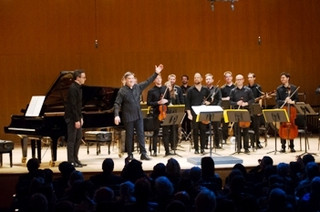|
Back
The Light Ligeti Fantastic New York
Grace Rainey Rogers Auditorium, Metropolitan Museum of Art
06/03/2016 -
New York Phil Second Biennial: “Ligeti Forward”
Alexandre Lunsqui: Three Short Pieces (Positions, Relevo.Eco, Jeuesquisse) – Kinetic Study 2 (*)
Unsuk Chin: Fantaisie mécanique (*)
György Ligeti: Piano Concerto
Conor Hanick (Piano)
Ensemble of the Lucerne Festival Alumni, David Fulmer (*), Alan Gilbert (Conductors)

C. Hanick, A. Gilbert, Lucerne Ensemble (© Paula Lobo)
The title for these three concerts at the Metropolitan Museum of Art could be a misnomer. “Ligeti Forward” possibly can’t be done. György Ligeti was a creature unto himself, neither forward not backward. Unlike Pierre Boulez, who created serious rules for serious games for serious people, Ligeti thought like a child. His rules were equally complex, his knowledge of physics and quantum jumps were extremely sophisticated. His music was equally complex. Yet, within this complexity was a humor, a childish ever-endearing simplicity.
Ligeti obviously knew that Einstein’s words, “God does not play dice with the universe.” But Ligeti was Hungarian, not German. It’s as if he thought to himself, “Well, what if God did play dice with the rules of the universe? Maybe it would sound like this.”
And he would compose one of several hundred works which enchanted with magic. And while the common man might not understand how he did it, nobody can resist loving the results.
So here, the New York Biennial festival has three full nights of György Ligeti, with Alan Gilbert the right conductor to do it. When he conducted Le Grand Macabre with the Philharmonic some years ago, he could have thrown out the outlandish puppets made for the occasion. The music said it all.
When he conducted the rarely performed Piano Concerto last night with a skeleton orchestra–single winds, percussion, brass, slide-whistle, ocarina and tiny string consort with piano–Mr. Gilbert didn’t need to give a push to pianist Conor Hanick. Ligeti’s music gave the impetus for five exciting movements. Those who had studied the piece knew about the duple meters, about the polymetric time signatures, about the sudden metronomic durations. Yet this was irrelevant. Unlike, say, Boulez and Stockhausen, Ligeti didn’t need a code. The results were on the keyboard.
Mr. Hanick’s opening wasn’t quite jazzy, because jazz has its own synchronicity. This was like a series of jazz dancers all going to different rhythms, all a bit off-kilter (or, like the French horn, with not-quite-right harmonic stops), never quite in sync, yet all playing their own dice-throwing in a craps game whose rules were never announced.
The second movement is labeled Lento e deserto, but nothing is sad here. This and the next movement could be different sides of a Béla Bartók “night music”, sounds coming out of whiplash trumpet calls or remote piano scales. Did Mr. Hanick give us a reminder of the first movement? Possibly. But that was like a mysterious reflection of something in memory. (Was this the “Ligeti Forward and Back” of the title?)
The fourth movement is supposed to be “fractals”, but nobody was aware of that. This was music which moved with jovial speed, leading to a finale which Stravinsky himself would have loved. Except that the “later” Stravinsky was averse to creating the carnivals and circuses of his youth. Ligeti never lost that youthful joy, and it showed both with Mr. Gilbert’s spot-on conducting and Mr. Hanick’s faultless, seemingly spontaneous pleasure.

U. Chin (© Courtesy of the Artist)
The evening started with two less known composers, although Unsuk Chin is always a welcome visitor. The Korean-born composer picks up errant sounds like a magnet and transforms them into music which can be aggressive or delicate as the needs call.
For Fantaisie mécanique, her soloists were one trumpet and one trombone, and in the background were two percussion players and piano. In about five movements, the different instruments played a variety of sounds, along with some great gymnastics from the percussion. Conductor David Fulmer managed to give the work a sense of volition, even excitement. If Ligeti’s music needed no explanation, perhaps a few words might have helped.
The evening began with fascinating works by the Brazilian-born Alexandre Lunsqui. The first were Three Short Pieces, all of them with the same idea. In Relevo, two violins played what seemed like a quirky melody in unison. But was it in unison? Perhaps they were told to play at their pace (the original aleatory idea), or perhaps the composer wrote out, to the fractional second, where they were to differ.
Ditto Eco and Jeuesquisse, for flute/clarinet and winds/piano respectively. Less than a minute each of blurry tunes just a bit off pitch, a bit off melody. This was followed by Kinetic Study 2, also with blurred melodies from the whole Lucerne Chamber Ensemble.
They were intriguing, jewel-like, delicious to hear. Yet after the concert, one realized that Ligeti’s 28-minute Piano Concerto was more compact, more intriguing and far more iridescent than Mr. Lunsqui’s table magic.
Harry Rolnick
|